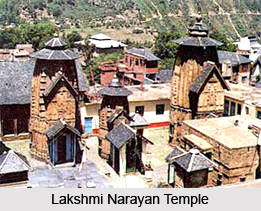 Lakshmi Narayan Temple is the oldest temple in the Lakshmi Narayan group of temples in Chamba district, Himachal Pradesh. There are six medieval stone temples of which three temples are consecrated to Lord Vishnu and other three to Lord Shiva. Built around 8th or 10th century by Sahil Varman, the temples resemble Shikhara style of architecture. They hone immense archaeological significance. The temple complex has several fine sculptures of deities like Lord Vishnu, Goddess Lakshmi, Narasimha (one of the 10 incarnations of Lord Vishnu) and Lord Krishna. Lakshmi Narayan temple can be approached from the Chamba Bus Station. This is regarded as the oldest and the largest one.
Lakshmi Narayan Temple is the oldest temple in the Lakshmi Narayan group of temples in Chamba district, Himachal Pradesh. There are six medieval stone temples of which three temples are consecrated to Lord Vishnu and other three to Lord Shiva. Built around 8th or 10th century by Sahil Varman, the temples resemble Shikhara style of architecture. They hone immense archaeological significance. The temple complex has several fine sculptures of deities like Lord Vishnu, Goddess Lakshmi, Narasimha (one of the 10 incarnations of Lord Vishnu) and Lord Krishna. Lakshmi Narayan temple can be approached from the Chamba Bus Station. This is regarded as the oldest and the largest one.
There are also some other temples in the complex, which altogether make the temple complex a beautiful and an attractive one. These other temples include the shrine of Radha Krishna, Shiva Temple of Chandergupta and Gauri Shankar Temple.
These temples were built in the 10th century but they were decorated by the Rajas who occupied the throne of Chamba afterwards. Raja Balabhadra Verma added the metallic image of Garuda on a high pillar at the main gate of the temple. Raja Chhatra Singh, on the other hand, contributed the gilded pinnacles on the temple tops. It was done as a protest against the orders of Aurangazeb to destroy the temple.
Legend states that Raja Sahil Verma, the constructor of this temple, sent nine of his sons to the Vindhya Mountains to get the marble suitable for the construction of the Vishnu idol. The marble that was brought contained a frog. This was considered as inauspicious and the sons were sent back to bring another marble for the required construction. All the sons got killed on their way back. The King was indomitable. He sent his elder son to bring the marble. The robbers also attacked him, but with the help of a saint he was able to defeat and kill his attackers and save himself. The Prince returned successfully with the marble required to make the image of Lord Vishnu in the temple. His name was Yugkara.
Architecturally, the Lakshmi Narayan is constructed in the Shikhara style. There is Bimana (shikhara), garbhgriha, and a mandapa like structure. The wooden chattris and the shell roofs reflect the climatic condition of the place where snowfall is quite expected.





















